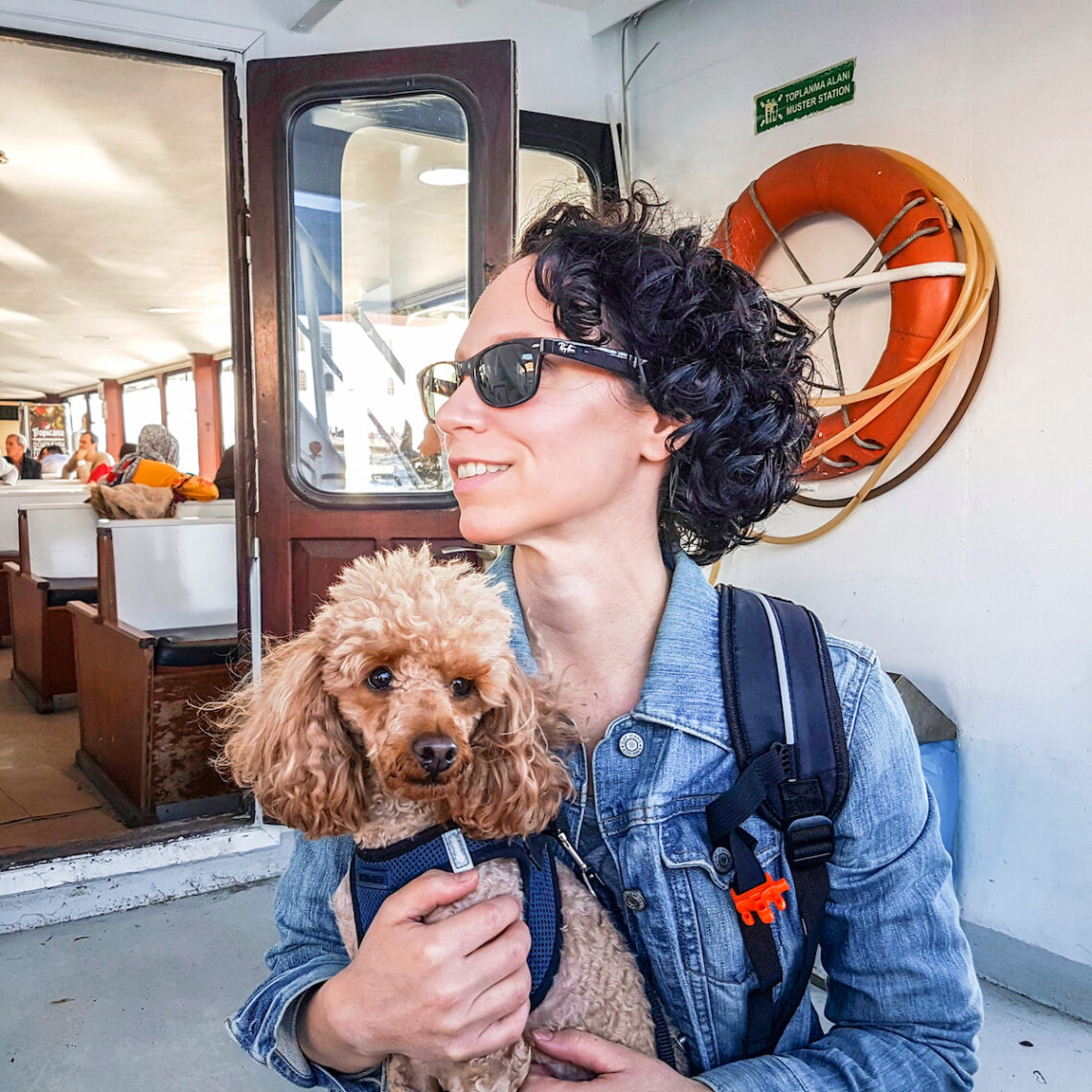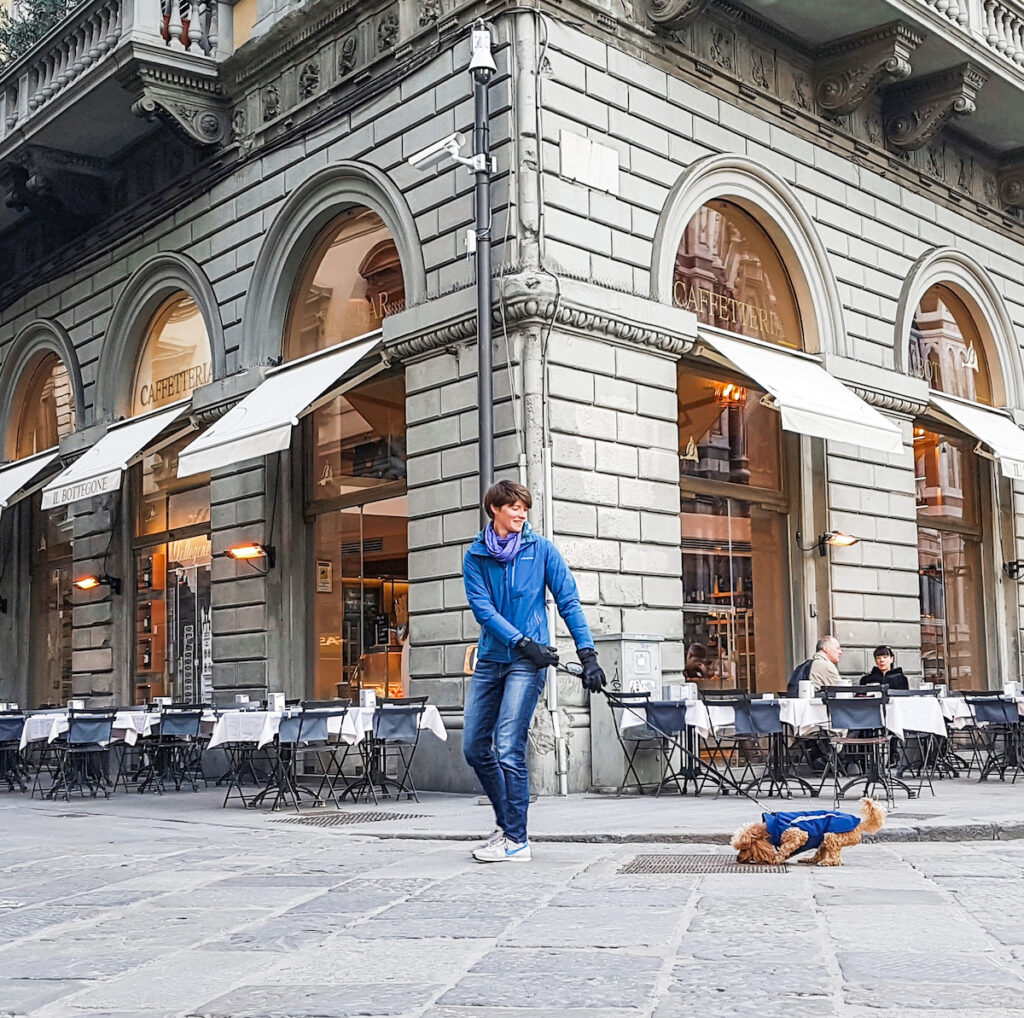
The Ultimate Guide to Traveling with a Dog
Everything we’ve learned after 15 countries and 35+ flights
Sometimes it happens when we’re wandering through an ancient ruin. Sometimes it’s when we’re relaxing at a seaside cafe. Wherever we travel with our two toy poodles, inevitably other tourists come up to us in amazement and ask if it’s really difficult to travel with our dogs.
And when we think about the research involved with deciphering a country’s pet import requirements, the hours spent booking flights and finding pet-friendly hotels and Airbnbs, the answer is always yes, it’s extremely difficult to travel with our dogs. But the opportunity to explore the world with our two little guys is totally worth the effort.
Lately we’ve received so many questions on this topic that we realized we are well overdue for sharing our hard-won tips and insights about traveling with dogs.
In this post and video, we’re covering all the basics that you need to know about before, during and after a flight with your dog. We’re sharing how to find a pet-friendly Airbnb; how to find a local vet; where to get food for your dog.
And we’re also discussing the real cost of traveling with your dog. That’s not just the obvious costs like booking your dog’s passage on flights. We’re also talking about the hidden costs, which can really add up.

The size of your dog
If you want to travel with your dog, the size of your dog will certainly factor into where you go and how you travel.
Jasper, the red one, is our biggest dog; he weighs 12 pounds or 5.5 kilos and he measures 13 inches or 33 cm from the floor to the top of his shoulders. And that’s really the absolute max for traveling in the cabin of the plane, especially in terms of height. He just barely fits for most airline requirements.

If you have a dog of Jasper’s size or smaller, then in-cabin travel is an option and that makes it really easy to fly all over the world. But if your dog is any bigger, you’re likely looking at flying him as checked baggage or maybe even cargo. This is much more stressful for the dog and you would likely want to limit the amount of flying that you do. You could consider one big flight to Europe, for example, and then slowly travel the region by train or by car.
Country requirements
Once you know how your dog can travel, the next thing to figure out is where you can go. That means understanding the country requirements for both importing and exporting a pet. And this is where pet travel can become very complicated.
Every country has its own set of rules and it’s really important to go directly to the source, e.g. the official government website, to get up-to-date information. Don’t be satisfied with what you read on blogs and forums. And feel free to send in your questions if you have them; in our experience, these government bodies generally respond in a timely manner.
However, government websites can sometimes be hard to find, not to mention that they might not be available in English. When we’re planning to visit a country, we always start by looking at the IATA Travel Centre website, which provides the basic pet import information along with relevant government links.
Also be aware that the import and export requirements vary widely from country to country. Sometimes you need to get a rabies titre test, which requires a very long lead time. Some countries require a letter from a vet and maybe even a stamp from the official government body, all within a short window prior to travel.
We had to deal with health certificates and official government approvals for both Ecuador and Colombia and it was a very time consuming process. When the import and export requirements are more extensive, it’s likely only worthwhile if you plan to spend a lot of time in the country. We were in Ecuador for three months and then in Colombia for another three months so it was definitely worth the effort.
If you’re planning to spend a lot of time traveling across Europe, we would recommend getting an EU pet passport, which is what we have for dogs. We picked these up in the first EU country we arrived in, which was Poland, and have been using them ever since.
However, it does take some effort to get an EU Pet Passport, but once you have it, you can just pop in and out of European countries and it’s so easy.

Airline requirements
Just like countries, airlines have their own requirements for accepting pets on board, whether in cabin, as checked baggage or as cargo. In fact, we’ve been turned away at check in because we didn’t have the right paperwork.
We were leaving Mexico, heading back to Canada, and to our surprise, the Aeromexico check in desk turned us away because we didn’t have a letter from a vet stating that the dogs were healthy and in good condition to travel. This wasn’t required by the governments of Mexico or Canada; it was the airline’s own requirement.
Fortunately we had arrived at the airport three hours early for the flight and had just enough time to locate a vet, go there, get the paperwork and get back to the airport in time for our flight. Naturally getting last minute paperwork from a vet an hour before your flight does not come cheap.
Aside from the letter from a vet — which we honestly haven’t seen very often — the usual airline requirements are typically focused on the size and weight of the pet carrier. As always, go directly to the airline website for the exact specifications.
You’ll notice as you start researching airlines that each one has slightly different dimensions for the carrier size. We personally use the Sturdi size large carrier. It has a flexible domed roof that is tall enough for our biggest dog but can also squish down to meet any airline height requirements.
By the way, airlines also have restrictions related to the age and breed of dog. Before even considering a flight with your dog, make sure to check with the airline website first.
Booking a flight
When it comes to booking your pet on a flight, for the most part this has to be done by calling in and talking to a customer service rep. There are a few airlines that will let you book your pet directly online but these are still very rare. And this is where traveling with a dog gets really time consuming. I can’t even begin to count up the hours that we have logged on hold with the customer service departments of countless airlines, trying to book our dogs.
First we decide on the flights we want — but we don’t buy them. Before any purchase can be made, we need to call and check if there is room for our two dogs on the flight. Every airline has limits on how many pets can travel on a flight; it varies by plane, by cabin, even by route. We would never risk buying tickets and then discovering there’s no room for our little guys.
Once customer service confirms that there’s space, we buy our tickets. Then we immediately call back and book the dogs. So you can see how we end up spending a lot of time on hold with customer service. And by the way, make sure you get evidence from the airline that the dog booking was successful.
The travel day
You’ve picked your destination; you’ve booked your flight; now it’s time for the big travel day. We always recommend getting to the airport with your dog way earlier than usual, ideally three hours early for an international flight. Checking in with your dog can be a really long process. Sometimes the agent might not be familiar with all the steps and needs to call in a supervisor; sometimes they need to take photocopies of every single document. Sometimes you might be sent to a different desk to pay for the pet in cabin service.
During the check in process it’s very likely that they will weigh the dog with the carrier and you do not want to be overweight even by a little because you may be denied boarding. If you’re worried about the weight, you can always strip down the carrier for the weigh in by emptying the pockets and removing any straps or handles.
Our dogs in their carriers have been weighed almost every time we’ve checked in. However no one has ever pulled out a tape measure and measured the carrier and only once has an agent questioned whether Jasper could comfortably stand up and turn around, which is the basic requirement.
Certainly you don’t want to give them any reason to deny you boarding; it can be very expensive and very time consuming to fix that issue.

Airbnbs, Vets, Food
That covers off the flying part of travel but there’s much more to traveling with a dog beyond boarding a flight.
First up, finding pet-friendly accommodations. We typically use Airbnb for our long stays, e.g. a month or longer. It’s possible to use the pet-friendly filter but will really limit the selection of apartments. We prefer to make a shortlist of 10 to 15 Airbnbs and ask the host directly if they would accept our dogs. We let them know that our dogs are quiet and well behaved, they don’t shed and that we’ll take good care of their Airbnb.
We do get a lot of no’s but we also get some yeses and we typically end up with a decent selection to choose from. This strategy works best if you already have a set of good reviews as a guest and it works even better if those reviews mention your dog. But you can build that up over time by being a polite and thoughtful guest.
For short stays, we will often turn to Booking and in this case we do use the pet-friendly filter as inns and hotels generally have a clear pet policy in place. However, we always message the hotel directly, just to make sure that the information on Booking aligns with their latest policies.
We also get asked about finding vets and finding good quality food for our dogs. The answer is similar for both. For the vets, we use Google maps and look for vets that have a great score and a lot of good reviews. We like to see at least some reviews in English as it indicates a vet has experience working with expats and hopefully has at least a little English.
For food, we do the same. We use Google maps to find pet stores that carry decent brands. One trick is to look at the photos of the store window and interior to see if you spot recognisable brands. Fortunately we’ve been able to find high quality dog food in most of the countries that we’ve traveled to. And if we can’t find it, we just make it at home.
The cost of traveling with a dog
Traveling with dogs involves all the obvious costs that you would expect to see. There’s the cost of flying with your pet; bringing a pet in cabin can cost as little as $25 USD for a budget carrier or as much as $150 USD for a major flight. There’s also the cost of any vet visits and health certificates if they’re needed. We spent over $300 USD for the paperwork to bring our dogs from Canada to Ecuador; that didn’t even include their flights.
There are also all the hidden costs. For example, you’ll always have a smaller pool of Airbnbs and hotels to choose from so you might end up staying in more expensive places. In Mexico City, we messaged 20 Airbnbs and only one said yes to our pets. And that one just happened to be the most expensive.
We also end up taking pricier flights. Most of the cheapest budget airlines don’t accept dogs so we usually end up going with the national carriers instead and that always costs more. As well, most buses also don’t accept dogs so we end up renting cars or taking expensive private transfers to get around.
After receiving all this information, if you’re still feeling nervous about traveling with your dog, we get it. There was a time when we felt that we were at a crossroads. We had a dream to travel the world but we thought that meant leaving our dogs behind. We really didn’t think we could both travel and be good dog parents. If you want to know what finally gave us the confidence to book that first flight, you can take a look at the next post.




8 Comments
Jennifer Vogel
We have a 20lb standard wirehaired dachshund. 9 inches tall and 21 long. This Saturday will be our first attempt at flying out of Canada. I am keeping my fingers xd we have no issues getting him on the plane. We have 3 more years to fire and the plan is adding 1 more doxie to the mix and traveling to Europe. It all hinges on this upcoming flight! Thanks for your inspiration and many tips.
Our Freedom Years
Apologies for the very late reply…we were enjoying a social media break! I hope your attempt at a flight went well. Your dog does sound a little on the large side for in cabin – fingers crossed it all worked out. Glad we could provide some inspiration for the dog travel. Having our two along with us has been fairly challenging but we honestly wouldn’t have traveled so long if we didn’t have them. They make every Airbnb feel more like home.
Anna Zisa
Super helpful article and website in general, thanks for sharing! Question: is your largest dog 13″ from floor to top of shoulder or from floor to top of head?
I’m considering getting a miniature or toy poodle. Ideally I’d prefer a mini but I’d like to be able to bring them with me on flights in the cabin, so I think it needs to be a toy. Your largest dog is rather big for a toy poodle, isn’t it? I’m confused with all different sizes! Thx
Our Freedom Years
Glad you found it helpful! Our largest dog is 13″ from floor to top of shoulder and he is at the very largest end of the scale for the toy size (possibly even a miniature by American Kennel Club standards!). In fact, he wouldn’t fit comfortably in most airline-approved bags unless they have a tall, flexible ceiling like the Sturdi carrier (which squishes down to fit under the seat). If you’re looking to travel with your dog in-cabin, I would strongly recommend a true toy poodle versus a miniature, which could grow up being too tall for in-cabin requirements.
Karon
Hi. Just curious, did you give your AirBnB address in Poland to obtain the EU Pet Passport? We just tried to get one in Bulgaria but were not successful without having a local address.
Our Freedom Years
We actually used our mailing address, which was in Canada. However, if that hadn’t been successful, we certainly would have tried with our Airbnb address.
Dana
I’m curious as I have travelled with my toy poddle to Mexico and other states in the US, but while there, had to restrain from going to places where my dog wasn’t allowed to enter (museums for example). What do you do with your poodles while you’re going to places they can’t come with you? My dog is very clingy so leaving her in hotel or airbnb has been stressful to say the least so have decided to go to places where she’s allowed to be with me.
Thank you!
Our Freedom Years
Great question! Our dogs also have serious separation anxiety so we never leave them alone in an Airbnb. Instead, if it’s a museum or gallery, usually we would go one at a time. If it’s more involving, such as a day trip to a archeological site, we would usually look to hire a pet sitter to come to the Airbnb and take care of them. There are a number of pet sitting platforms that we’ve tried and had good luck with finding someone responsible to spend time with them while we’re out for the day. However, we make sure that they’ve had a good walk in advance so that the pet sitter doesn’t need to take them out.